The Ontario College of Pharmacy (OCP) just released it’s 2015 Annual Report and once again it’s filled with great information on the college and the profession. I encourage all pharmacists to check it out.
But if you’re a busy pharmacist who just wants a quick summary, I got you covered. In this post I’ll focus on what I think is the best part of the report: the pharmacy trends section. I’ll also examine what impact these trends may have on the future of pharmacist salaries in Ontario.
Skip to the Good Part: Clues on the Future of Pharmacist Salaries in Ontario
I’ve always been one to skip ahead when reading (i.e. I always read the last pages in a murder mystery book first, to find out who the killer is). The OCP report is no different.
 Like I said, the annual report has a lot of great information. This year has a new section on social media. (Which reminds me: If you haven’t already, make sure to follow the OCP on Facebook and Twitter.)
Like I said, the annual report has a lot of great information. This year has a new section on social media. (Which reminds me: If you haven’t already, make sure to follow the OCP on Facebook and Twitter.)
But I think the juiciest part of the report is the section on pharmacy trends. And we put that information to good use.
One of the things we follow closely at PharmacistsFirst.com is pharmacist salaries in Canada. And like anyone who has taken an economics class knows, the forces of supply and demand influence all markets.
We pay close attention to the pharmacist and pharmacy stats in the OCP reports.
So what are the numbers this year? Let’s get to it!
The Number of Pharmacists in Ontario:
In 2015, the number of pharmacists in Ontario hit 15,113. That’s a 5% increase from the year before – a fairly consistent growth rate over the last five years. That growth rate may not sound like much, but it’s a big deal when you compound it over several years.
To put that into perspective, since 2010 (the year the OCP registered its 12,000 pharmacist) the population of Ontario pharmacists has grown by over 25%.
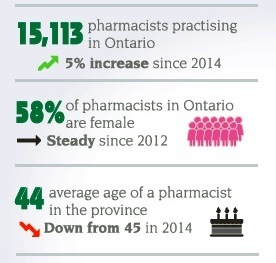
Source: OCP 2015 Annual Report
The gender split between male and female pharmacists has been fairly consistent over the last five years at 58% female, 42% male.
Also, the pharmacist population is getting slightly younger. In 2015, the average age of pharmacists was 44, compared to the average age of 45 over the last two years.
Pharmacist Practice Type in Ontario
Community pharmacy continues to be largest employer of pharmacists in Ontario. In 2015, there were 10,266 community pharmacists in Ontario (76% of all Ontario pharmacists). That compares to 8,388 community pharmacists in 2010 (68% of all Ontario pharmacists).
The next biggest group were hospital pharmacists at 2,363 (17% of all Ontario pharmacists). That compares to 1,930 hospital pharmacists in 2010 (16% of all Ontario pharmacists).
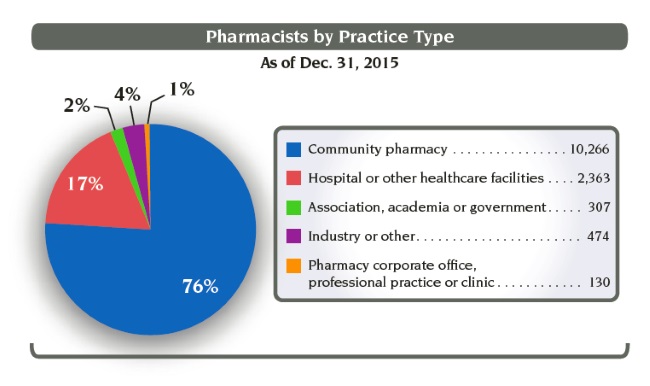
Source: OCP 2015 Annual Report
Newly Registered Pharmacists in Ontario:
There were 999 new pharmacists registered in Ontario in 2015, a 15% increase from last year. That compares to 688 new additions in 2010. Half of the new pharmacists in 2015 were educated internationally.
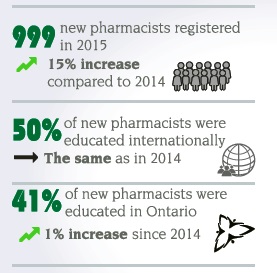
Source: OCP 2015 Annual Report
One of the interesting trends is the number of new pharmacists that are educated in Ontario. In 2015, 412 new pharmacists were educated in Ontario, compared to 202 pharmacists in 2012: a 103% increase! Of course that has a lot to do with the University of Waterloo opening their Pharmacy School during this time.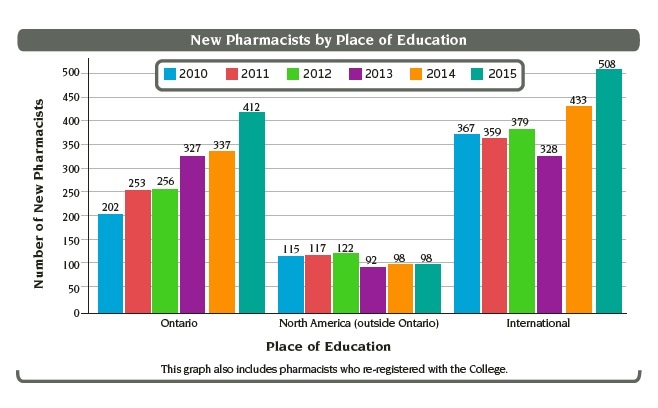
Source: OCP 2015 Annual Report
The Number of Pharmacies in Ontario:
In 2015, the number of pharmacies in Ontario rose to 4,012. That compares to 3,427 pharmacies in 2010. The number of pharmacies over the last five years in Canada has grown by 17%.
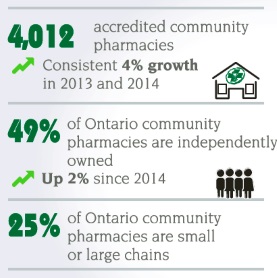
Source: OCP 2015 Annual Report
The vast majority of pharmacies in Ontario are independently owned. This group also saw the biggest growth over the last five years. There were 1,967 independents operating in 2015, compared to 1,673 independents in 2010 (18% growth over the last five years).
Banner stores were the next largest group. There were 1,051 banner stores in 2015, vs 926 banner stores in 2010 (13% growth over the last five years).
The biggest event impacting the number of stores in Ontario was the closing of all 133 Target Canada stores. Most of these stores were located in Ontario, which explains the fall in banner stores in 2015. This was accompanied with a small spike in independent store openings in 2015.
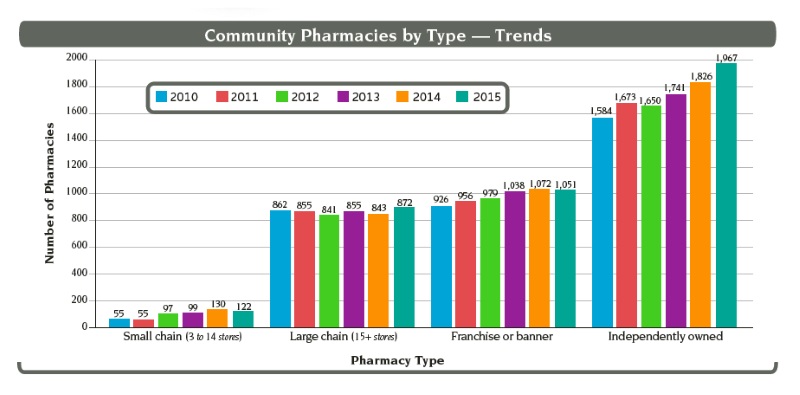
Source: OCP 2015 Annual Report
Growth in the Number of Ontario Pharmacists:
Over the last five years, the number of pharmacists in Ontario has growth by 25%. The increase in the number of pharmacists during this time was over 3 times greater than the population growth.
To put the growth of pharmacists into perspective, the CIHI publishes the number of pharmacists per 100,000 population. The number of pharmacists per person increased from 79 per 100,000 population in 2009 to 83 per 100,000 population in 2012.
Using the latest population and pharmacist estimates, the number of pharmacists per person in Ontario is 110 per 100,000 population in 2015.
What Does This Mean for Pharmacist Salaries in Ontario?
At first glace, the growth in the pharmacist population seems to be causing a glut in the market. This is consistent with our data, too.
The 25% growth in Ontario pharmacists over the last five years is much greater than the growth in Ontario’s population (4% over the last five years. Source: Statistics Canada).
The growth in Ontario pharmacists has also been greater than than the growth in the “65 years of age and older” demographic (17% growth over the last five years. Source: Statistics Canada). This group has historically been the biggest user of pharmacy services
The growth in the number of pharmacists in Ontario at least partly explains why the labour market has been so tough. This is especially true for the new pharmacists entering the market.
Our data shows that hourly wages are stable in most areas. However, many new pharmacists are splitting time between multiple employers and locations.
But there is a silver lining. The industry is transforming rapidly, which is impacting the demand side for pharmacists. The scope of pharmacy practice is expanding (i.e. 60% of Ontario pharmacists are registered to administer injections). As governments look to make better use of their healthcare spending, I think more services will be handed to pharmacists – a highly skilled and highly efficient group of healthcare professionals.
Pharmacy technicians will help in this trend. Remember when dentists were responsible for scraping plaque off patient’s teeth? That task was eventually taken over by dental hygienists. I think many tasks currently performed by pharmacists will eventually be transferred to technicians. This will free up pharmacists to take on future expanded services.
Overall, I think the future is bright for the profession in Ontario. There will certainly be growing pains as the profession deals with what appears to be a glut in new pharmacists.
But the expanded scope of the pharmacy profession will have a long lasting effect on the future. Like the dental industry twenty-five years ago, I think pharmacy is on the cusp on a major positive transformation. Stay tuned…




